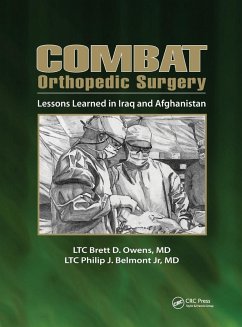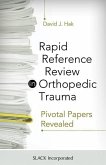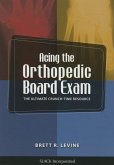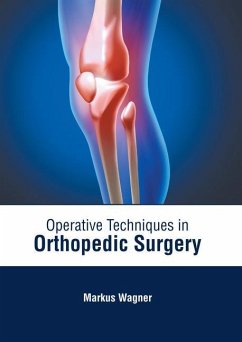- Gebundenes Buch
- Merkliste
- Auf die Merkliste
- Bewerten Bewerten
- Teilen
- Produkt teilen
- Produkterinnerung
- Produkterinnerung
The widespread use of individual and vehicular body armor, evolution of enemy tactics to include its reliance on improvised explosive devices, and the effectiveness of treatment rendered at military treatment facilities have resulted in a large burden of complex orthopedic injuries.
Andere Kunden interessierten sich auch für
![Rapid Reference Review in Orthopedic Trauma Rapid Reference Review in Orthopedic Trauma]() David HakRapid Reference Review in Orthopedic Trauma99,99 €
David HakRapid Reference Review in Orthopedic Trauma99,99 €![Orthopedic Trauma Call for the Attending Surgeon Orthopedic Trauma Call for the Attending Surgeon]() David HakOrthopedic Trauma Call for the Attending Surgeon183,99 €
David HakOrthopedic Trauma Call for the Attending Surgeon183,99 €![Acing the Orthopedic Board Exam Acing the Orthopedic Board Exam]() Brett LevineAcing the Orthopedic Board Exam165,99 €
Brett LevineAcing the Orthopedic Board Exam165,99 €![Orthopedic Residency and Fellowship Orthopedic Residency and Fellowship]() Laith JazrawiOrthopedic Residency and Fellowship95,99 €
Laith JazrawiOrthopedic Residency and Fellowship95,99 €![Operative Techniques in Orthopedic Surgery Operative Techniques in Orthopedic Surgery]() Operative Techniques in Orthopedic Surgery147,99 €
Operative Techniques in Orthopedic Surgery147,99 €![Combat Medicine Combat Medicine]() George Tsokos / James AtkinsCombat Medicine219,99 €
George Tsokos / James AtkinsCombat Medicine219,99 €![Combat Medicine Combat Medicine]() Combat Medicine149,99 €
Combat Medicine149,99 €-
-
-
The widespread use of individual and vehicular body armor, evolution of enemy tactics to include its reliance on improvised explosive devices, and the effectiveness of treatment rendered at military treatment facilities have resulted in a large burden of complex orthopedic injuries.
Hinweis: Dieser Artikel kann nur an eine deutsche Lieferadresse ausgeliefert werden.
Hinweis: Dieser Artikel kann nur an eine deutsche Lieferadresse ausgeliefert werden.
Produktdetails
- Produktdetails
- Verlag: CRC Press
- Seitenzahl: 352
- Erscheinungstermin: 15. Februar 2011
- Englisch
- Abmessung: 286mm x 221mm x 23mm
- Gewicht: 1146g
- ISBN-13: 9781556429651
- ISBN-10: 1556429657
- Artikelnr.: 34667571
- Herstellerkennzeichnung
- Libri GmbH
- Europaallee 1
- 36244 Bad Hersfeld
- gpsr@libri.de
- Verlag: CRC Press
- Seitenzahl: 352
- Erscheinungstermin: 15. Februar 2011
- Englisch
- Abmessung: 286mm x 221mm x 23mm
- Gewicht: 1146g
- ISBN-13: 9781556429651
- ISBN-10: 1556429657
- Artikelnr.: 34667571
- Herstellerkennzeichnung
- Libri GmbH
- Europaallee 1
- 36244 Bad Hersfeld
- gpsr@libri.de
LTC Brett D. Owens, MD is a Distinguished Graduate of the United States Military Academy in West Point, New York. He graduated from the Georgetown University School of Medicine in Washington, DC and completed his internship at Walter Reed Army Medical Center. He completed his orthopaedic surgery residency at the University of Massachusetts and the John A. Feagin Jr. Sports Medicine Fellowship at West Point. He is currently an Associate Professor of Surgery (Orthopaedics) at the Uniformed Services University of the Health Sciences in Bethesda, Maryland. He served as an orthopaedic surgeon with the 86th Combat Support Hospital in Iraq and is currently Chief of Orthopaedic Surgery Service, Keller Army Hospital, West Point, New York. LTC Philip J. Belmont Jr, MD is a Distinguished Graduate of the United States Military Academy in West Point, New York. He graduated from the Duke University School of Medicine in Durham, North Carolina and completed his internship and orthopaedic surgery residency at Walter Reed Army Medical Center in Washington, DC. He is currently an Associate Professor of Surgery (Orthopaedics) at the Uniformed Services University of the Health Sciences in Bethesda, Maryland. He served as an orthopaedic surgeon with the 228th Combat Support Hospital in Iraq and is currently the Chief of Adult Reconstruction and Program Director of the William Beaumont Army Medical Center/Texas Tech University Health Sciences Center Orthopaedic Surgery Residency Program at William Beaumont Army Medical Center, El Paso, Texas.
Preface Foreword by Foreword Introduction Section I Principles Chapter 1
The History of Combat Orthopedic Surgery Chapter 2 The Combat Environment
and Epidemiology of Musculoskeletal Combat Casualties Chapter 3 Echelons of
Care Chapter 4 The Forward Surgical Team Chapter 5 Combat Support Hospitals
Chapter 6 Landstuhl Regional Medical Center II Advancements Chapter 7
Ballistic, Blast, and Burn Injury: Science and Clinical Implications
Chapter 8 Management of Complex Combat-Related Soft Tissue Wounds/ Negative
Pressure Wound Therapy Chapter 9 Basic Science of War Wounds Chapter 10
Heterotopic Ossification Chapter 11 Irrigation and Debridement Chapter 12
Tissue Engineering and Regeneration Chapter 13 Infection in Orthopedic
Extremity Injuries Chapter 14 Tourniquets Chapter 15 External Fixation
Principles Section III Upper Extremity Chapter 16 Upper Extremity Nerve
Chapter 17 Upper Extremity Amputations Chapter 18 Upper Extremity Coverage:
Management of Combat-Related Soft Tissue Injury of the Upper Extremity
Chapter 19 Complex Reconstructive Challenges in Hand and Forearm Wounds
Chapter 20 Complex Elbow and Shoulder Injuries Section IV Lower Extremity
Chapter 21 Lower Extremity Limb Salvage
The History of Combat Orthopedic Surgery Chapter 2 The Combat Environment
and Epidemiology of Musculoskeletal Combat Casualties Chapter 3 Echelons of
Care Chapter 4 The Forward Surgical Team Chapter 5 Combat Support Hospitals
Chapter 6 Landstuhl Regional Medical Center II Advancements Chapter 7
Ballistic, Blast, and Burn Injury: Science and Clinical Implications
Chapter 8 Management of Complex Combat-Related Soft Tissue Wounds/ Negative
Pressure Wound Therapy Chapter 9 Basic Science of War Wounds Chapter 10
Heterotopic Ossification Chapter 11 Irrigation and Debridement Chapter 12
Tissue Engineering and Regeneration Chapter 13 Infection in Orthopedic
Extremity Injuries Chapter 14 Tourniquets Chapter 15 External Fixation
Principles Section III Upper Extremity Chapter 16 Upper Extremity Nerve
Chapter 17 Upper Extremity Amputations Chapter 18 Upper Extremity Coverage:
Management of Combat-Related Soft Tissue Injury of the Upper Extremity
Chapter 19 Complex Reconstructive Challenges in Hand and Forearm Wounds
Chapter 20 Complex Elbow and Shoulder Injuries Section IV Lower Extremity
Chapter 21 Lower Extremity Limb Salvage
Preface Foreword by Foreword Introduction Section I Principles Chapter 1
The History of Combat Orthopedic Surgery Chapter 2 The Combat Environment
and Epidemiology of Musculoskeletal Combat Casualties Chapter 3 Echelons of
Care Chapter 4 The Forward Surgical Team Chapter 5 Combat Support Hospitals
Chapter 6 Landstuhl Regional Medical Center II Advancements Chapter 7
Ballistic, Blast, and Burn Injury: Science and Clinical Implications
Chapter 8 Management of Complex Combat-Related Soft Tissue Wounds/ Negative
Pressure Wound Therapy Chapter 9 Basic Science of War Wounds Chapter 10
Heterotopic Ossification Chapter 11 Irrigation and Debridement Chapter 12
Tissue Engineering and Regeneration Chapter 13 Infection in Orthopedic
Extremity Injuries Chapter 14 Tourniquets Chapter 15 External Fixation
Principles Section III Upper Extremity Chapter 16 Upper Extremity Nerve
Chapter 17 Upper Extremity Amputations Chapter 18 Upper Extremity Coverage:
Management of Combat-Related Soft Tissue Injury of the Upper Extremity
Chapter 19 Complex Reconstructive Challenges in Hand and Forearm Wounds
Chapter 20 Complex Elbow and Shoulder Injuries Section IV Lower Extremity
Chapter 21 Lower Extremity Limb Salvage
The History of Combat Orthopedic Surgery Chapter 2 The Combat Environment
and Epidemiology of Musculoskeletal Combat Casualties Chapter 3 Echelons of
Care Chapter 4 The Forward Surgical Team Chapter 5 Combat Support Hospitals
Chapter 6 Landstuhl Regional Medical Center II Advancements Chapter 7
Ballistic, Blast, and Burn Injury: Science and Clinical Implications
Chapter 8 Management of Complex Combat-Related Soft Tissue Wounds/ Negative
Pressure Wound Therapy Chapter 9 Basic Science of War Wounds Chapter 10
Heterotopic Ossification Chapter 11 Irrigation and Debridement Chapter 12
Tissue Engineering and Regeneration Chapter 13 Infection in Orthopedic
Extremity Injuries Chapter 14 Tourniquets Chapter 15 External Fixation
Principles Section III Upper Extremity Chapter 16 Upper Extremity Nerve
Chapter 17 Upper Extremity Amputations Chapter 18 Upper Extremity Coverage:
Management of Combat-Related Soft Tissue Injury of the Upper Extremity
Chapter 19 Complex Reconstructive Challenges in Hand and Forearm Wounds
Chapter 20 Complex Elbow and Shoulder Injuries Section IV Lower Extremity
Chapter 21 Lower Extremity Limb Salvage








